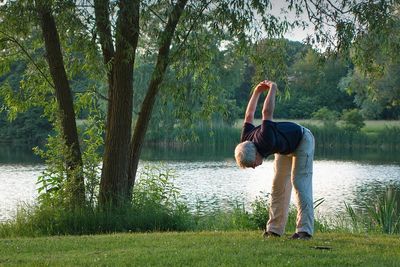When a layperson hears the term spinal fusion, many people involuntarily conjure up the image of someone who can barely move. What is this procedure really all about? When is spinal fusion indicated and what alternatives are there?
What is spinal fusion?
A spinal fusion (spondylodesis) represents the connection of the vertebral bodies, including the small vertebral joints, through professional spinal surgery. In this way, misalignments can be eliminated, worn and overloaded small vertebral joints can be immobilized, or severely sunken disc spaces can be expanded. The connection is usually made by screws. These are connected to rods, which is known as a fixator.
The worn out intervertebral discs are replaced with placeholders in the shape of a basket. These are filled with artificial or the body's own bone material. This leads to bony spinal stiffening. Technically speaking, it is a vertebral body fusion.
What could be the reasons why a spinal fusion seems necessary?
Accidents and wear and tear can lead to instability and loosening in parts of the spine. This can lead to degenerative diseases, which are often accompanied by unbearable pain. A misalignment of the spine is also a possible cause of stiffness. Curvatures can endanger health. In some cases, other causes of misalignment include a hunched back or scoliosis (sideways bending of the spine).
Pressed or constricted nerves are another indicator of spinal stiffness. The canals of the spine contain spinal cords with countless nerves. When the canal is narrowed, pain and discomfort occur.
Reasons that may suggest spinal fusion:
- Wear and tear and accidents
- Misalignments of the spine
- Nerve constriction (spinal canal stenosis)
Which other treatment methods should have been clarified beforehand?
It is essential to understand that spinal fusion is only indicated when all other alternatives have been ruled out and when this treatment can be expected to result in a clear improvement in the current situation, i.e. less or no pain at all and more mobility . Before spinal fusion (spondylodesis) is considered, weight reduction, physiotherapy with muscle building and pain management can be helpful. This can lead to an improvement in symptoms. But even then, wear and tear can continue to progress, causing further problems. Surgery may be considered and may lead to an improvement in quality of life.
Alternatives to spinal fusion
An alternative to spinal fusion can be the implantation of a so-called artificial intervertebral disc, which is then inserted into the space between the vertebrae. The height is then adjusted. This allows the normal spinal structure to be restored. In addition, the mobility of the vertebrae can be reconstructed.
What follow-up treatment is necessary?
Rehabilitation is often necessary after spinal fusion. Temporary movement restrictions may need to be taken into account. Depending on the individual surgical method and condition of the patient, they receive individual advice on rehabilitation options. Resilience, domestic situation and self-sufficiency are influential.
Why the Apex-Spine spine center in Munich is the right contact
At the Apex-Spine Spine Center in Munich, extremely experienced and professional contacts advise their patients on prevention, pain therapy and diagnosis of spinal problems. The clinic and the specialists working there are completely specialized in the topic of spinal problems and spinal surgery and have years of experience in treating back problems. The required treatment is developed individually based on the diagnosis and discussed with the patient.
Thanks to its consistent specialization and international experience, the Apex-Spine spine center is the perfect and experienced partner when it comes to spinal fusion. The specialists provide thorough and comprehensive advice on problems in the affected region and carry out a very precise diagnosis.

